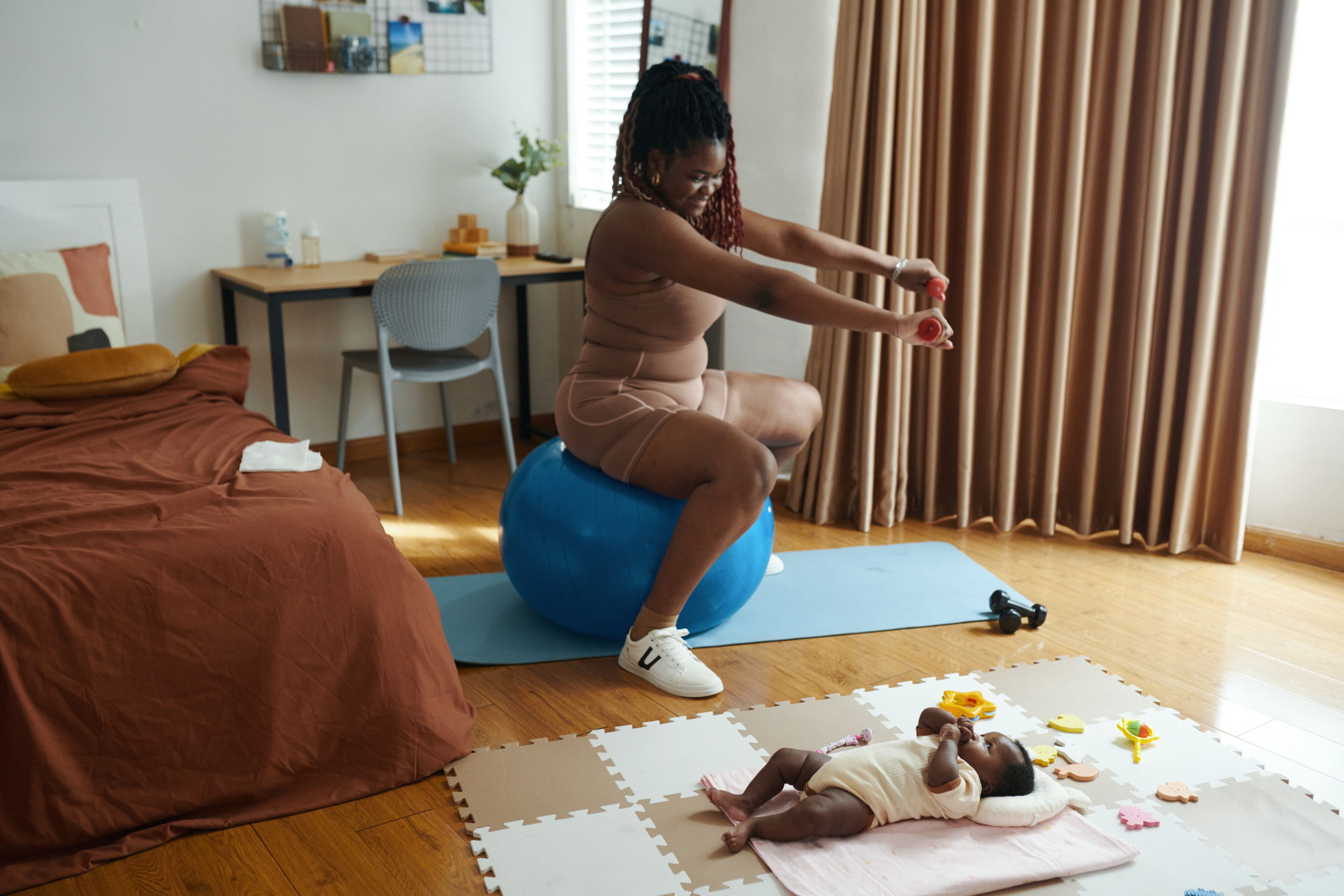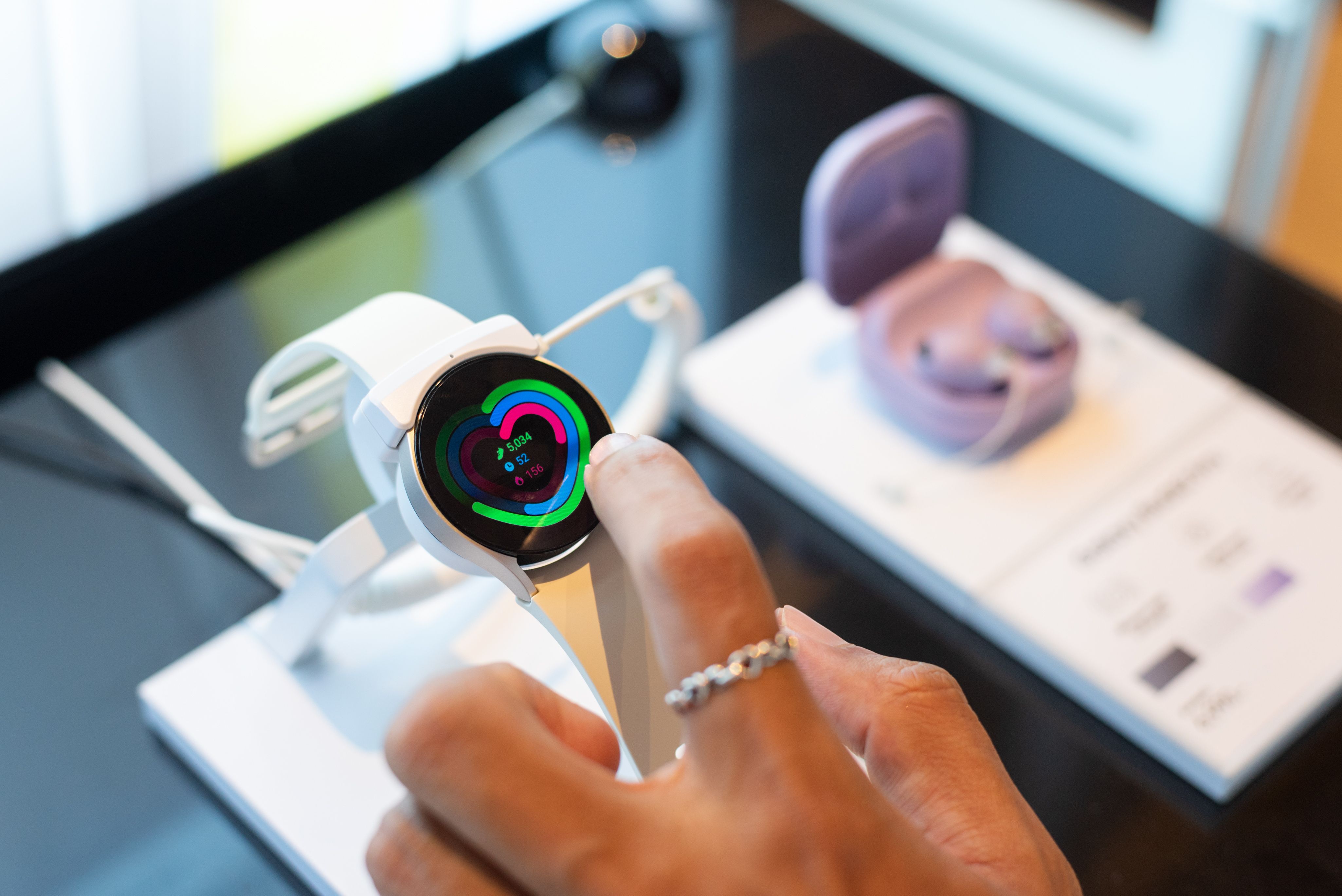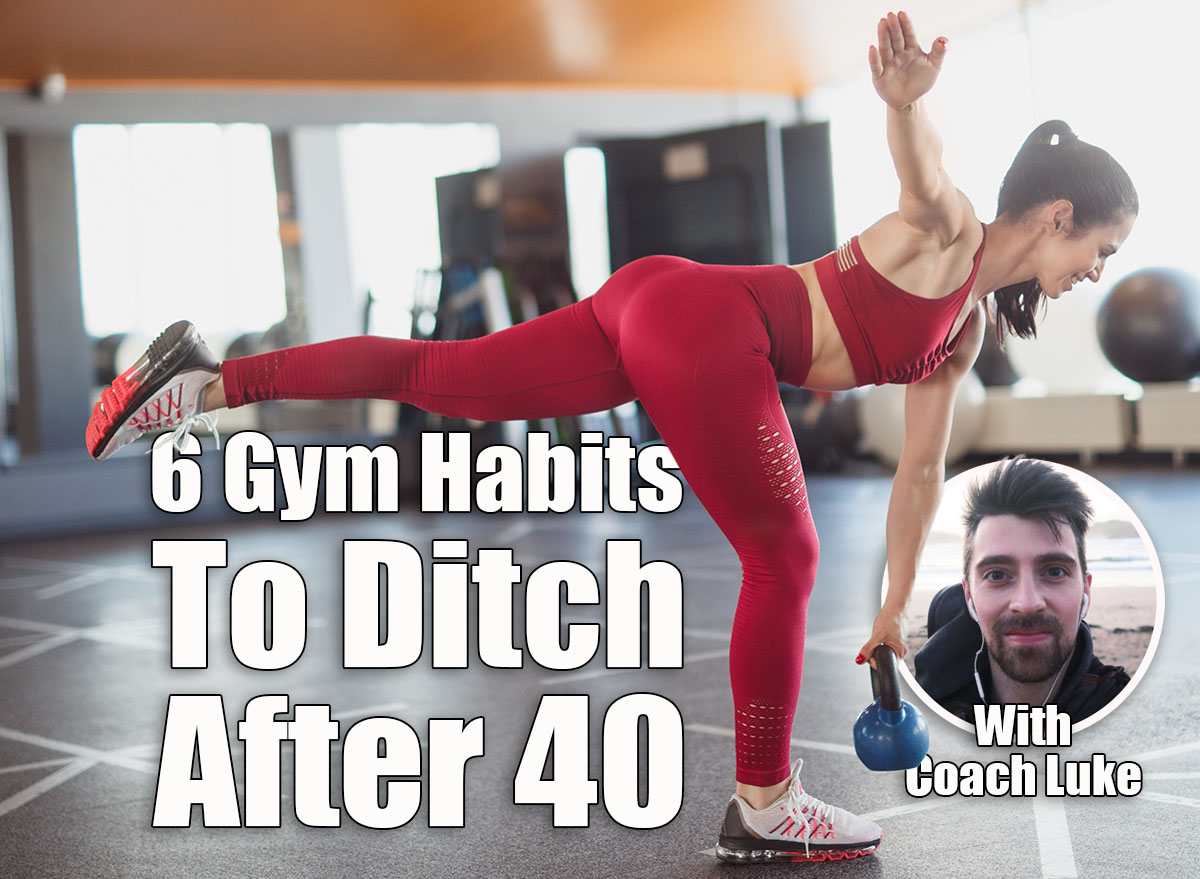Fitness
Scientists reveal just how many hours of exercise new moms need each week

New moms are being strongly encouraged to engage in at least two hours of moderate to vigorous physical activity each week in the first three months after giving birth, according to new guidelines published in the British Medical Journal.
A panel of researchers and clinicians analyzed 574 studies to develop these updated postpartum exercise guidelines.
Their findings highlight the benefits of physical activity in reducing postpartum depression, weight retention, sleep disturbances and risks of chronic conditions such as diabetes and cardiovascular disease.
DragonImages
For new mothers without medical complications, the experts recommend a combination of activities such as brisk walking, cycling and muscle-strengthening exercises for at least 120 minutes per week—ideally spread over four or more days.
They also stress the importance of daily pelvic floor exercises to prevent urinary incontinence and aid recovery.
Guidelines co-author and physiologist professor Margie Davenport of the University of Alberta told Newsweek that historically, new mothers were advised to wait until six weeks after birth to start exercising.
“While this recommendation is intended to ensure adequate healing and recovery, some women are ready to be physically active well before six weeks, and others well after six weeks postpartum,” she said.
The new guidelines suggest that the progression to 120 minutes of moderate to vigorous physical activity should be personalized, gradual and based on individual symptoms.
Newsweek also spoke to Emily Claman, a certified prenatal and postnatal fitness expert, who explained that early movement soon after childbirth can help new moms recover.
“In those first three months, your exercise routine should focus on rebuilding strength, especially in the core and pelvic floor muscles, as well as restoring your posture, mobility and alignment,” she said.
Physical activity also boosts mental health, enhances energy and improves sleep quality, which is crucial for both physical and mental recovery, Claman added.
For mothers recovering from c-sections or birth complications, body mechanics expert and lead trainer at barre3 Lisa Schale-Drake suggests easing in gradually.
“Returning to exercise after having a baby can feel overwhelming and uncertain,” she said. “Let go of any set timeline and focus on rebuilding your strength in a way that feels right for you.”
A good place to start is breathwork to help rebuild the muscles in the deep layers of the core. Schale-Drake also advised seeking support from a pelvic floor physical therapist if needed.
The expert researchers stressed that all new mothers, regardless of complications, should aim to incorporate light daily movement, such as gentle walking, to avoid the risks associated with inactivity.
One of the biggest challenges for new moms is finding the time and energy to exercise. Both Claman and Schale-Drake agreed that workouts don’t need to be time-consuming to be effective.
“Time is precious as a new mom, so setting up a routine for yourself is the best way to make sure you stay consistent,” Clamnan told Newsweek.
Working out during nap time or taking two classes a week at a postpartum-focused studio can be great ways to stay active, she added.
Schale-Drake encouraged “exercise snacks,” aiming for five to 10 minutes of exercise rather than a 30-minute chunk.
Walking is also a great method of exercise for new moms—a “simple yet effective way to support your recovery,” she said.
Davenport also explained that the guidelines include a “Get Active Questionnaire” to help women determine when after birth it is safe to resume physical activity.
Postpartum depression, diastasis recti [where the vertical muscles of the abdomen separate] and pelvic floor issues are not considered reasons to avoid postpartum physical activity, Davenport said.
However, she continued, they can be common barriers to such exercise—and may call for additional screening, support and treatment by a healthcare provider or qualified exercise professional.
While meeting these updated recommendations may be challenging for some new mothers, expert researchers said that small efforts can make a difference.
“Even small steps towards achieving them will still promote physical and mental health benefits,” the panel said in a statement.
Do you have a tip on a health story that Newsweek should be covering? Do you have a question about postpartum recovery? Let us know via science@newsweek.com.
Reference
Davenport, M. H., Ruchat, S.-M., Jaramillo Garcia, A., Ali, M. U., Forte, M., Beamish, N., Fleming, K., Adamo, K. B., Brunet-Pagé, É., Chari, R., Lane, K. N., Mottola, M. F., & Neil-Sztramko, S. E. (2025). 2025 Canadian guideline for physical activity, sedentary behaviour and sleep throughout the first year postpartum. British Journal of Sports Medicine, 59(515–526). https://doi.org/10.1136/bjsports-2025-109785

Fitness
I took a class to boost my VO2 max — and finally found a way to make cardio fun
I have a strange question, but stay with me: Have you ever thought about how long you can run without breathing through your mouth? In a dark basement in central London I recently discovered that, for me, the answer is: Not for very long.
Apparently, that means my VO2 max, or ability to send oxygenated blood to my muscles, and how well my muscles can use that oxygen during intense exercise, is quite low.
Translation: I’m unfit.
I do low-impact strength training like yoga and pilates most days, but no cardio. I’ve tried to get into running, but it never sticks, and I find cardio machines boring.
I learned specifically how bad I am at cardio at V02:MAXED, a new class at London’s GymBox. I knew one session wouldn’t transform my health, but I was interested to try the first class I’d seen marketed around VO2 max.
I wondered if exercising with a specific goal might motivate me to finally form a cardio habit, and if the class — and the nose strips we had to wear while working out — was just a fad.
Once the preserve of high-level athletes, in recent years, VO2 max has become a buzzy measure of cardiovascular fitness among runners, fitness competition enthusiasts, and health optimization bros. People are obsessed with it because it’s said to be a strong predictor of longevity.
As I’m not an endurance athlete, my low score may not seem like a big deal, but having a high VO2 max is linked to a longer life, and a reduced risk of conditions including cardiovascular disease, cancer, and diabetes.
I don’t care that I can’t run five kilometers in under 30 minutes, but I do care about staying active and healthy as I age.
To increase your VO2 max, you have to do a mixture of shorter high-intensity and longer, easier workouts. VO2:Maxed is a 16-week course where clients train at a range of intensities. The class I did was the fourth in the series.
Feeling nervous about entering a gym that uses the words “gnarly,” “sadistic,” and “savage” to describe some of its classes, I descended the staircase from the reception area to the dimly lit bodybuilder’s playground below with trepidation.
Kim Schewitz
We had to breathe through our noses for as long as possible
In the 50-minute class, we repeated three-minute sets on a stroke machine (ski or rower) and a cycle machine (bike or treadmill), with 45-second breaks in between. I used a ski machine and an assault bike.
What made the class unique was the breathwork. Our instructor, Firas Iskandarani, a Hyrox and Crossfit coach, explained that we should aim to breathe through our noses for most of the class. He called this type of breathing “gear one,” and breathing in through the nose and out through the mouth “gear two.”
We were told to note when we had to “switch gears.” Iskandarani said this should happen after around 90-seconds to two-minutes, but I struggled to get to one minute.
As a rough guide, the longer you can stay in gear one, the higher your VO2 max is likely to be, he said. The idea is that, over time, you will need to switch gears less quickly, which indicates your aerobic capacity has increased.
About halfway through the class, we were given nasal strips to stick on the fleshy part of our noses, and encouraged to notice if it helped us stay in gear one for longer.
It’s thought that widening the nasal canal could help to increase endurance by allowing more air through the nose. But one 2020 meta-analysis published in the European Archives of Oto-Rhino-Laryngology found that wearing a nasal strip while exercising didn’t improve VO2 Max or heart rate. Still, lots of runners and athletes swear by them, like the elite tennis player Carlos Alcaraz, who wears them during his matches.
I felt that the nasal strip helped a little, but it kept peeling off as my nose got sweaty.
Breathing through your nose while exercising is thought to help you stay in Zone 2
Nasal breathing is not directly linked to improving VO2 max, but is thought to help the body use oxygen more efficiently.
It also encourages you to stay in Zone 2, or at 60-70% of your maximum heart rate, while you’re exercising. Your muscles have more access to oxygen in Zone 2, making it an effective way to increase aerobic endurance.
Once you enter Zone 3, 70% to 80% of your max heart rate, you’re moving at an intensity that’s too much for the available oxygen supply, which causes you to get out of breath.
Breathing through my nose and doing cardio at the same time was hard
I found there was a lot to remember and focus on in this class: not only understanding the different gears, but trying to stay in gear one while checking the clock to see when I started mouth breathing.
All of this mental arithmetic was required on top of the three-minute sets of cardio, which, I think is fair to say, is a long time. My mind kept wandering and I kept accidentally mouth breathing before I’d actually reached my threshold.
It was also tricky to go at a slow enough pace to stay in gear one for even a minute. After about thirty seconds I started to lose my breath. I suppose that tells me I have some work to do in this area.
That being said, I wasn’t huffing and puffing or red in the face afterwards like I usually am after a 35-minute run. But my arms did get very tired from pulling the ropes on the ski machine and moving the handles on the assault bike back and forth.
Kim Schewitz
A structured class made working on my cardio feel more achievable
If I did this class again I would pace myself better so that I wouldn’t get out of breath so quickly. But I think for a cardio beginner like me, it was a little too technical and advanced.
Iskandarani said that part of the demand for the class came from Hyrox fans and CrossFitters, who are already pretty fit and looking to increase their endurance for competitions.
But I found doing cardio in such a structured way and with a group of people much more fun and motivating than doing it alone. Going forward, I think I’ll stick to cardio classes rather than running every once in a while, getting bored, and trying again when enough time has passed for me to forget how arduous I found it.
By focusing on my breath, it became apparent that my cardiovascular fitness is lower than I’d like, and I’m only 28. I wondered how it would inevitably deteriorate over time, and if I’m struggling to get through a class like this now, it’s only going to get harder when I’m in my 50s, let alone 80s.
As for the VO2 max workout, I don’t think it was the right cardio class for me, but it’s motivated me to continue my search. Anyone for Zumba?
Fitness
Exercise As Medicine: How Physical Activity Supports Cancer Prevention And Recovery

Last Updated:
Recent research has shown how regular exercise and movement can play a role in reducing cancer risk. An expert decodes how physical activity can greatly help cancer patients.
Aerobic exercise and strength training aid cancer prevention and recovery.
In the evolving world of cancer care, exercise is emerging as more than just a lifestyle choice – it’s becoming a pillar of prevention and recovery. While traditionally associated with weight control and cardiovascular health, regular physical activity is now backed by strong scientific evidence for its role in reducing cancer risk, improving treatment outcomes, and enhancing quality of life during and after therapy.
Dr. Devesh S Ballal, Consultant – Surgical Oncology & Robotic Surgery, Manipal Hospital Old Airport Road, Bengaluru, answers how exercise plays a role in cancer prevention.
How does regular physical activity impact cancer prevention, according to current research?
Dr Ballal said, “There are numerous trials that support the fact that exercise lowers the risk of cancer. Exercise reduces insulin resistance and inflammation, enhances immune surveillance, and helps control systemic inflammation – all of which play a role in cancer development.”
He added, “Obesity, aside from its known impact on heart health, is a significant risk factor for nearly 13 types of cancer, with particularly strong links to breast, uterine, and colorectal cancers. A large-scale study published in the British Journal of Sports Medicine, involving 85,000 individuals, revealed that regular physical activity can reduce cancer risk by up to 26%.”
Is there scientific evidence linking specific types of exercise to reduced cancer risk?
Dr Ballal said, “Aerobic exercise and strength training both contribute to cancer prevention and are also beneficial during treatment and recovery. The American Cancer Society recommends that adults aim for at least 300 minutes of moderate-intensity exercise per week. Additionally, recent research from Tata Memorial Hospital shows that yoga, especially for breast cancer patients, provides tangible physical and mental health benefits.”
How safe is it for patients to exercise during cancer treatment, like chemotherapy or radiation?
Contrary to popular belief, bed rest is rarely beneficial. Supervised exercise regimens are encouraged even during chemotherapy and radiation. Dr Ballal suggested, “While treatment-related fatigue may limit intensity, staying active helps preserve muscle mass, reduce fatigue, and improve overall well-being. Importantly, exercise plans should be customized to individual capacity and limitations to ensure safety and effectiveness.”
What role does physical activity play in improving long-term outcomes and survival rates?
Exercise is fast becoming a central component in long-term cancer care. Dr Ballal said, “A landmark study in the New England Journal of Medicine found that a structured exercise routine for patients recovering from colon cancer surgery and chemotherapy reduced the risk of recurrence by 28% and the risk of death by 37%. That’s a benefit comparable to chemotherapy, making movement a vital form of medicine in itself.”
Are there standard exercise guidelines for cancer patients or survivors?
Dr Ballal noted, “Yes. Guidelines from bodies like the American Cancer Society and the National Comprehensive Cancer Network (NCCN) offer practical frameworks for integrating exercise into recovery plans. The NCCN also outlines which patients may require medical clearance before beginning an exercise regimen. For example, individuals with osteoporosis should avoid high-impact activities due to fracture risk.”
Does exercise help reduce the side effects of cancer treatments, such as fatigue or neuropathy?
Clinical trials have demonstrated that regular, supervised physical activity can reduce cancer-related fatigue more effectively than medication alone. Dr Ballal said, “Exercise also improves balance and coordination, which helps manage chemotherapy-induced peripheral neuropathy. Simply put, movement plays a powerful role in easing side effects and promoting overall recovery.”
Physical activity is no longer just a supportive tool – it’s a crucial aspect of cancer care. With mounting evidence showing its ability to prevent cancer, improve treatment outcomes, and enhance quality of life, exercise is now recognised as a vital prescription in oncology – one that empowers patients to take active control of their healing journey.
view comments
- Location :
Delhi, India, India
- First Published:
Fitness
iFIT, Samsung Health partner to deliver personalized fitness through Galaxy devices

iFIT partners with Samsung Health for fitness through Galaxy devices: ©David Bokuchava – stock.adobe.com
iFIT and Samsung Health are joining forces to bring personalized, connected fitness experiences to millions of users around the globe, the companies announced Monday.
The partnership will integrate iFIT’s interactive content and intelligent fitness equipment with Samsung’s Galaxy ecosystem, giving users access to an expansive library of health and wellness programming—including strength training, yoga, cardio, mindfulness and recovery content—through the Samsung Health app. The content will begin rolling out this fall in 10 countries, including the U.S., U.K., India, and Germany.
“Personalized wellness is the future—and together with Samsung Health, we’re helping millions of people engage in healthier, more balanced lives across the globe,” said Kevin Duffy, CEO of iFIT. “Our iFIT content inspires people to work out more. Using real-time data to go beyond reps and heart rates delivers smarter, more intuitive guidance to actually drive results.”
Samsung Health users with compatible Galaxy devices such as the Galaxy Ring or Galaxy Watch will be able to access selected iFIT content for a monthly or annual fee. The integration promises to offer a more tailored experience by leveraging health data and AI-powered insights directly from users’ wearable devices.
Dr. Hon Pak, senior vice president and head of the digital health team for Samsung’s mobile business, said the collaboration demonstrates the company’s commitment to preventive health and digital wellness.
“Through Samsung Health, we aim to provide highly personalized fitness experiences that empower individuals to adopt healthier behaviors and enhance their well-being,” Pak said.
Connected Fitness Expands With Personalized, AI-Driven Experiences
The health tech landscape is rapidly evolving as consumer demand for more personalized, data-driven wellness tools continues to surge. At the center of this transformation is the growing role of artificial intelligence and wearables, which are helping users monitor, understand, and act on their health in real time.
Advancements in biometric sensors and mobile health platforms have made it easier than ever to collect meaningful health data—ranging from heart rate variability and sleep patterns to stress levels and metabolic indicators. The latest generation of wearable devices now serves as round-the-clock health companions, with some models even offering early warning signs for conditions such as atrial fibrillation or sleep apnea.
Artificial intelligence has further enhanced the value of these devices by interpreting complex data into actionable insights. AI-driven coaching can provide users with personalized exercise routines, dietary suggestions, and mental wellness interventions based on their unique health profiles and daily patterns.
Meanwhile, the integration of fitness content with mobile ecosystems means users no longer have to juggle separate apps and devices. Instead, they’re experiencing seamless transitions between workout recommendations, health record tracking, and motivational coaching—all on a single platform.
As more companies collaborate across fitness and tech sectors, these innovations are shaping a future in which preventive health is accessible, engaging, and deeply personalized for users at every fitness level.
-

 News1 week ago
News1 week agoVideo: Trump Compliments President of Liberia on His ‘Beautiful English’
-
Finance1 week ago
Do you really save money on Prime Day?
-

 News1 week ago
News1 week agoTexas Flooding Map: See How the Floodwaters Rose Along the Guadalupe River
-

 News6 days ago
News6 days agoVideo: Clashes After Immigration Raid at California Cannabis Farm
-

 Politics1 week ago
Politics1 week agoJournalist who refused to duck during Trump assassination attempt reflects on Butler rally in new book
-

 Politics1 week ago
Politics1 week agoObama officials used dossier to probe, brief Trump despite knowing it was unverified 'internet rumor'
-

 News1 week ago
News1 week agoDOGE keeps gaining access to sensitive data. Now, it can cut off billions to farmers
-

 World6 days ago
World6 days agoNew amnesty law for human rights abuses in Peru prompts fury, action




















